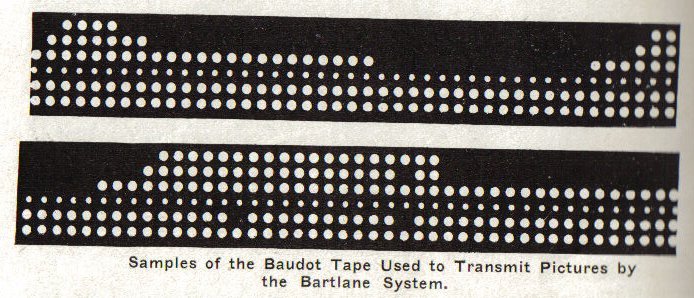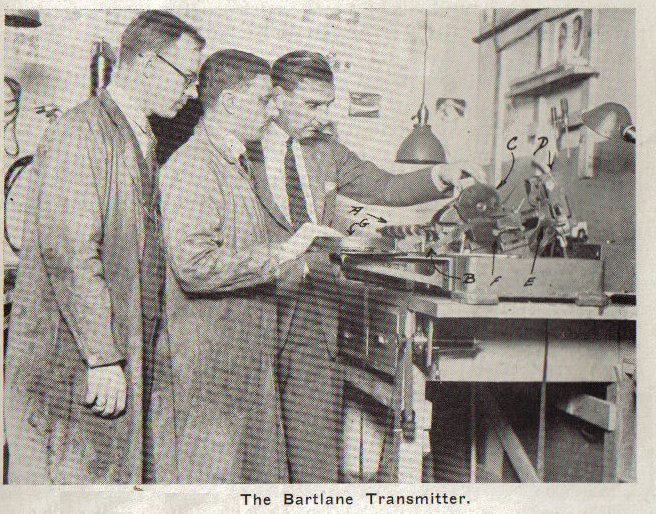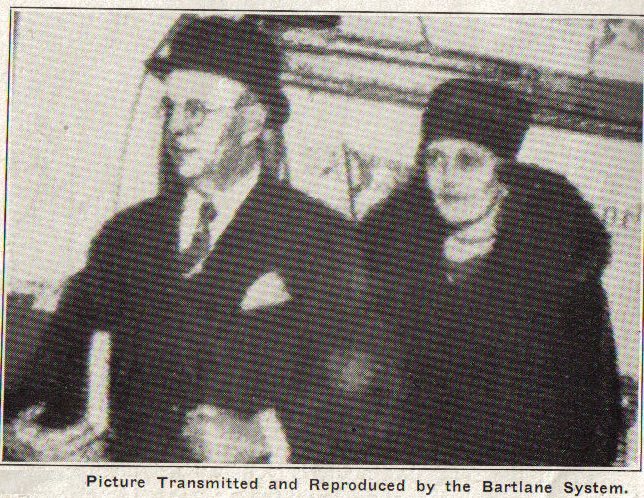|
|
||||||||||||||||||||||||||||||||||
|
The Bartlane System (Coded System) We will now consider the Bartlane method of picture transmission which is at present being worked over trans-Atlantic cables, but which can be adapted to radiotelegraphic use. The name Bartlane is coined from the names of its two inventors, Mr. Bartholomew and Captain MacFarlane, both of the Daily Mirror of London, England. This system was invented in 1920 and the first trans-Atlantic cable picture was transmitted in 1921, between London and Halifax, N.S. It is like Korn system, in that it employs the telegraphic typewriter to convert the picture values into those that will fit our standart forms of communication. The Bartlane system utilizes the telegraphic typewriter to an even greater extent than the Korn system and one of the basic elements is the Baudot Tape.
The Figure shows samples of the Baudot Tape as used in the transmission of pictures by the Bartlane system. This type of tape is the one most used by English and American automatic telegraph printer systems. It consists of a central guide hole, three holes on one side of the guide hole and two holes on the other side. The combination of certain holes, transmits certain impulses, which actuate the typewriter keys at the receiving station. Synchronism is positive and is effected by the central or guide hole. In transmitting a picture by the Bartlane system, an ordinary photograph of the subject for transmission is made first. With the negative film thus obtained as a basis, five tint plates are made, by allowing five different periods of exposure. Plate No. 1, for instance, might be exposed for two seconds; plate No. 2, for four seconds, etc. These plates are made of zinc and when they are developed, they will have a certain amount of insulating surface over part of the plate, which is, in effect, the half-tone characteristic. These plates will show an increasing amount of insulating area as the time of exposure, in the process of making the plate, is increased. These five tint plates are attached to a rotating cylinder which is motor driven and synchronized with the tape punching equipment. Each of the tint plates has an electrical contact finger which operates its particular punch magnet, when a part of the tint plate having no insulating surface, touches the contact finger. In each unit length of tape, there is a space in which each of the five punches, operated by the contact fingers functioning on the five tint plates, may make a hole. From the foregoing explanation you can get an idea how the tonal values that make up the picture for transmission, are changed into electric values by the contacts on the tint plates, and are then registered on the transmiting tape. When there is a clear spot on all five tint plates, the contacts, “making” the circuit through the five punch magnets, will be closed and five holes will be punched in the transmitting tape. As the cylinderis rotated spirally, all sections of the picture will eventually be passed over, and its respective shade punched in the tape. By use of this tape, signals will then be transmitted over the regular wire or radio printer, circuit and on the receiving end will actuate what is termed a “reperforator”
This Figure shows the arrangement of the Bartlane picture transmitter.
The “reperforator” is a machine which receives the oncoming electrical impulses and translates them back into a tape that should be the exact duplicate of the transmitting tape. In the receiver, a beam light is focussed upon the tape as it is passed through. The amount of light that is permitted to pass through this tape, is, of course, determined by the number of holes in the path of the beam of light. This light after passing through the tape is focussed on a photographic film which is inside a light tight box. This film is wrapped around a cylinder which i sthe same size as the transmitter cylinder and its speed is regulated by means of the central synchronizing holes in the received tape. A summary of the action involved shows that the picture for transmission is obtained in the form of a negative photographic film; five tint plates are made from this film and the picture is recorded on a transmitting tape, the five holes in the tape representing five different tonal values. Signals are transmitted to the receiver by means of the tape, these signals being translated back into the form of a tape again. Each of the five unit holes in the tape registers a definite tonal value on a recording film by means of a beam of light which is focussed on the tape as it passes through the receiving apparatus. The outstanding features of the Bartlane system, are, (C) Marius Rensen
|
|
[History] [Historical] [Korn] [Jenkins] [Bartlane] [Belin] [Gray] [Caselli] [Hummel] [Progress of Wire Facsimile] [Start of Radio Facsimile] [Commercial Point to Point] [Broadcast] [Facsimile Tape] [Comparison of Wire and Radio] [Radio Propagation] [Radio Facsimile Systems] [Scanning Equipment] [Mechanical Scanning] [Recorders] [Synchronizing] [Facsimile Tape] [Machine Design] [Multi Channel] [Color Facsimile] [General] [Conclusion] [Inventors] [Facsimile Makers] [Patents] [Home] [Home] |


